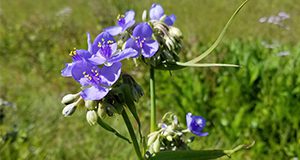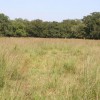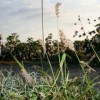Whitehead broom, also known as shrubby false buttonweed or southern larraflower, is becoming problematic in south Florida pastures, hayfields, and rights-of-way. This 2-page fact sheet discusses a few options to control this species. Written by Brent Sellers and James McWhorter, and published by the UF Agronomy Department, August 2016.
http://edis.ifas.ufl.edu/ag409
Tag: Pasture Weeds
Spiderwort Control in Hay Fields and Pastures

Spiderwort is a native perennial species found throughout the eastern half of the US. The plant’s large, fleshy stem creates problems for hay production. This 2-page fact sheet provides a brief overview of the plant as well as information on control through herbicide use. Written by Michael Durham, Jason Ferrell, and Brent Sellers, and published by the UF Agronomy Department, May 2016.
http://edis.ifas.ufl.edu/ag407
Smutgrass Control in Perennial Grass Pastures
 Smutgrass is a serious weed of improved perennial grass pastures, roadsides, natural areas, and waste areas in Florida. A 2003 survey found that smutgrass was second only to tropical soda apple as the most problematic weed species in Florida pastures, but now that practices to control tropical soda apple have been widely adopted in Florida, smutgrass is likely the most problematic weed species in Florida pastures today. This 4-page fact sheet was written by Brent Sellers, J. A. Ferrell, and N. Rana, and published by the UF Department of Agronomy, January 2015. (Photo Credit: B. Sellers, UF/IFAS)
Smutgrass is a serious weed of improved perennial grass pastures, roadsides, natural areas, and waste areas in Florida. A 2003 survey found that smutgrass was second only to tropical soda apple as the most problematic weed species in Florida pastures, but now that practices to control tropical soda apple have been widely adopted in Florida, smutgrass is likely the most problematic weed species in Florida pastures today. This 4-page fact sheet was written by Brent Sellers, J. A. Ferrell, and N. Rana, and published by the UF Department of Agronomy, January 2015. (Photo Credit: B. Sellers, UF/IFAS)
http://edis.ifas.ufl.edu/aa261
Identification and Control of Coral Ardisia (Ardisia crenata): A Potentially Poisonous Plant.
 Coral ardisia, also known as coral berry, spice berry, and scratchthroat, was introduced to Florida in the early 1900’s for ornamental purposes. Since then, it has escaped cultivation, and it is found in hardwood hammocks and other moist, natural-wooded areas and grazing lands. Although there is no published literature supporting the theory that coral ardisia is toxic, it is suspected that the berries and/or foliage are poisonous to livestock, pets, and humans. This 3-page fact sheet was written by B. A. Sellers, Sarah Lancaster, K. A. Langeland, J.A. Ferrell, Michael Meisenberg, and J. Walter, and published by the UF Department of Agronomy, November 2013.
Coral ardisia, also known as coral berry, spice berry, and scratchthroat, was introduced to Florida in the early 1900’s for ornamental purposes. Since then, it has escaped cultivation, and it is found in hardwood hammocks and other moist, natural-wooded areas and grazing lands. Although there is no published literature supporting the theory that coral ardisia is toxic, it is suspected that the berries and/or foliage are poisonous to livestock, pets, and humans. This 3-page fact sheet was written by B. A. Sellers, Sarah Lancaster, K. A. Langeland, J.A. Ferrell, Michael Meisenberg, and J. Walter, and published by the UF Department of Agronomy, November 2013.
http://edis.ifas.ufl.edu/ag281
Identification and Control of Southern Sandbur (Cenchrus echinatus L.) in Hayfields (SSAGR364/AG373)
 Southern sandbur is an annual grass that grows in pastures and cropland throughout the warm areas of the southern United States from Virginia to California. This native grass is adapted to dry, sandy soils and has a shallow, fibrous root system. It can easily invade a poorly managed field, diminishing the quality of a hay crop or grazing pasture. Southern sandbur seeds start to germinate in late spring, and germination continues through the summer and fall. Flowering occurs in late fall, and growth is consistent until the first frost. This 2-page fact sheet was written by Hunter Smith, Jason Ferrell, and Brent Sellers, and published by the UF Department of Agronomy, December 2012.
Southern sandbur is an annual grass that grows in pastures and cropland throughout the warm areas of the southern United States from Virginia to California. This native grass is adapted to dry, sandy soils and has a shallow, fibrous root system. It can easily invade a poorly managed field, diminishing the quality of a hay crop or grazing pasture. Southern sandbur seeds start to germinate in late spring, and germination continues through the summer and fall. Flowering occurs in late fall, and growth is consistent until the first frost. This 2-page fact sheet was written by Hunter Smith, Jason Ferrell, and Brent Sellers, and published by the UF Department of Agronomy, December 2012.
http://edis.ifas.ufl.edu/ag373
Control of Lantana in Pastures (SSAGR359/AG368)
Lantana is currently one of the top 10 most troublesome weeds in Florida. Although it is still sold as an ornamental, commercial varieties are sterile and considered to be non-invasive. It can quickly invade disturbed sites by producing plant toxins in its roots and stems, that either slow the growth of other plants or totally remove them. These leaf toxins are damaging to grazing animals. If animals consume the leaves, they often begin to show symptoms of skin peeling or cracking. Once animals show these symptoms, there is little or no treatment that can reverse the process. Although lantana’s leaves are poisonous, its berries are not. Birds readily consume the fruit and disperse the seed. This 2-page fact sheet was written by J. Ferrell, B. Sellers, and E. Jennings, and published by the UF Department of Agronomy, February 2012.
http://edis.ifas.ufl.edu/ag368
Bracken Fern Control in Pastures (SSAGR357/AG366)
 Bracken fern is a poisonous plant common along tree lines, in forest openings, and around building borders. Animals will consum it when adequate forage is not available. Learn more in this 2-page fact sheet was written by J. Ferrell, B. Sellers, and T. Wilson , and published by the UF Department of Agronomy, December 2011.
Bracken fern is a poisonous plant common along tree lines, in forest openings, and around building borders. Animals will consum it when adequate forage is not available. Learn more in this 2-page fact sheet was written by J. Ferrell, B. Sellers, and T. Wilson , and published by the UF Department of Agronomy, December 2011.
http://edis.ifas.ufl.edu/ag366
Prickly Pear Cactus Control in Pastures (SSAGR354/AG363)
 Prickly pear cactus is not a problem in every pasture in Florida, but where it is found, it is often the biggest and most difficult issue to manage: mowing prickly pear fragments the pads and dramatically increases the infestation, and although prickly pear doesn’t form dense canopies and doesn’t outcompete desirable forage grasses, its impact on grazing can be just as severe because of its barbed quills. This 2-page fact sheet was written by J. A. Ferrell and B. A. Sellers, and published by the UF Department of Agronomy, September 2011.
Prickly pear cactus is not a problem in every pasture in Florida, but where it is found, it is often the biggest and most difficult issue to manage: mowing prickly pear fragments the pads and dramatically increases the infestation, and although prickly pear doesn’t form dense canopies and doesn’t outcompete desirable forage grasses, its impact on grazing can be just as severe because of its barbed quills. This 2-page fact sheet was written by J. A. Ferrell and B. A. Sellers, and published by the UF Department of Agronomy, September 2011.
http://edis.ifas.ufl.edu/ag363
Flat-top Goldenrod (Euthamia caroliniana): Biology and Control in Pastures (SS-AGR-353/AG361)
 This perennial plant, which flowers September – November with flat-topped inflorescence consisting of many yellow ray and disk flowers, is a common weed found in pastures with low levels of management. Learn more in this 3-page fact sheet was written by B. A. Sellers and J. A. Ferrell and published by the UF Department of Agronomy, September 2011.
This perennial plant, which flowers September – November with flat-topped inflorescence consisting of many yellow ray and disk flowers, is a common weed found in pastures with low levels of management. Learn more in this 3-page fact sheet was written by B. A. Sellers and J. A. Ferrell and published by the UF Department of Agronomy, September 2011.
http://edis.ifas.ufl.edu/ag361
SSAGR326/AG336 Wax Myrtle Biology and Control in Pastures
SS-AGR-326, a 3-page illustrated fact sheet by Brent Sellers, J. Ferrell, and Reyna Speckmann, describes the biology and control of this native evergreen shrub that, in dense infestations, can completely eliminate bahiagrass stands in pastures. Published by the UF Department of Agronomy, November 2009.
http://edis.ifas.ufl.edu/AG336
SSAGR18/AA261 Smutgrass Control in Perennial Grass Pastures
Revised! SS-AGR-18, a 4-page illustrated fact sheet by Brent Sellers, J. A. Ferrell, and J. J. Mullahey, describes the biology, outlines control recommendations for this serious weed of improved perennial grass pastures, roadsides, natural areas, and waste areas in Florida. Published by the UF Department of Agronomy, November 2009.
http://edis.ifas.ufl.edu/AA261
SSAGR325/AG335 Soft Rush (Juncus effusus) Biology and Control in Pastures
SS-AGR-325, a 3-page illustrated fact sheet by Brent Sellers, Jason Ferrell, and Reyna Speckmann, describes this clump-forming perennial plant that frequently infests low-lying areas in Florida pastures — biology, control, forage tolerance, management, and recommendation. Published by the UF Department of Agronomy, November 2009.
http://edis.ifas.ufl.edu/AG335
SSAGR08/WG006 Weed Management in Pastures and Rangeland – 2009
Revised! SS-AGR-08, a 13-page fact sheet by B.A. Sellers and J.A. Ferrell, describes mechanical control, sanitation, chemical control, postemergence applications, and precautions to take when using phenoxy or benzoic acid herbicides. Published by the UF Department of Agronomy, February 2009.
http://edis.ifas.ufl.edu/WG006
SSAGR307/AG313 Biology and Control of Indian Jujube (Ziziphus mauritiana): A Weed to Watch in Florida Pastures and Natural Areas
SS-AGR-307, a 3-page illustrated fact sheet by Brent Sellers, describes this large shrub native to southern Asia and eastern Africa, and which is reported in Miami-Dade, Lee, and Glades counties — it’s identification, habitat and ecology, spread, and conrol. Includes references. Published by the UF Department of Agronomy, August 2008.
http://edis.ifas.ufl.edu/AG313
SS AGR 304/AG311 Mexican Prickly Poppy: Biology and Control
SS-AGR-304, a 2-page illustrated fact sheet by Brent Sellers, describes biology and control of this annual or biennial member of the poppy family, also known as goatweed, Mexican thistle, prickly poppy and yellow thistle. Published by the UF Department of Agronomy, May 2008.
http://edis.ifas.ufl.edu/AG311
